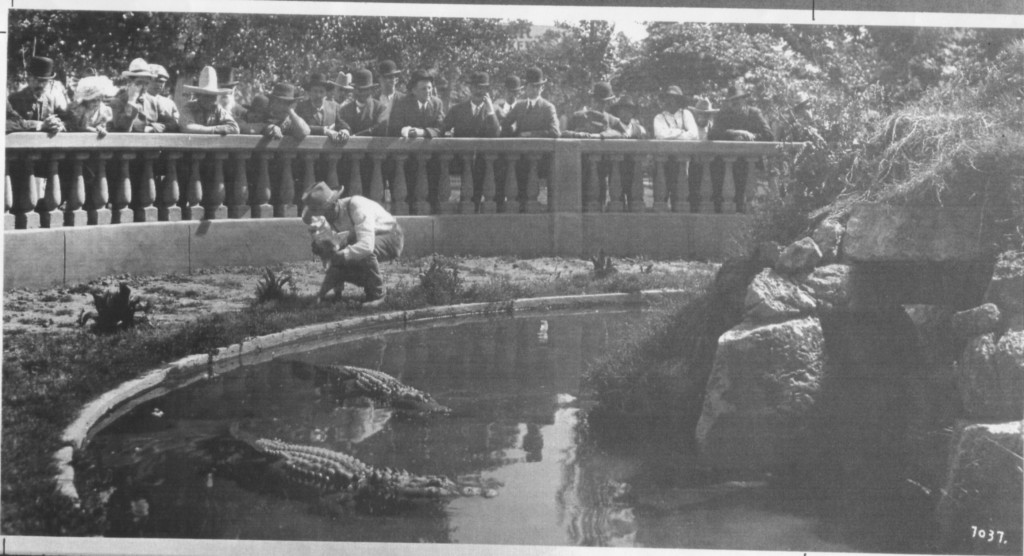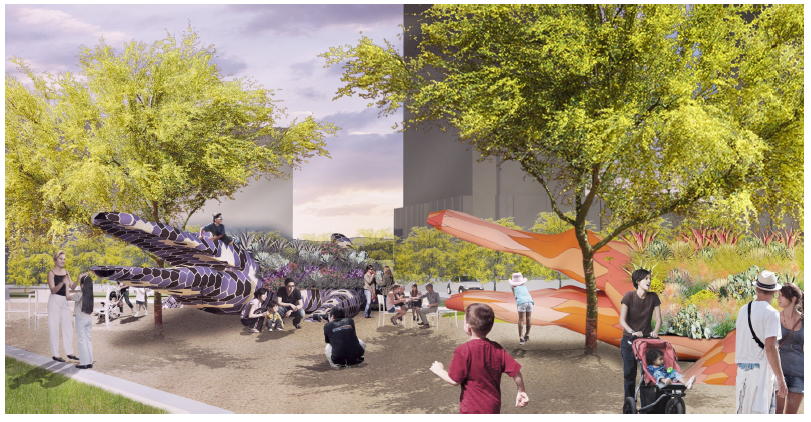San Jacinto Plaza
The downtown San Jacinto Plaza Park is on the verge of reconstruction. The Final plan to remodel the historic city block was presented to the public on June 20, by City officials at the El Paso Museum of History. The plan received mixed reviews from the public.
This is an historic event. The park is one of El Paso’s most important icons. It has survived the 154-year history of the city.
The initial name given to the park was Public Square. It has been called the Central Plaza, La Plaza, La Placita, The Alligator Park, Parque de Los Lagartos, and El Parque.
Anson Mills, who later became Mayor, surveyed and platted the first subdivision in El Paso, named the Plat of the Town of El Paso, in 1859, and his actions marked the birth of our city. On the plat, Anson Mills wrote on one of the city blocks “City Square.”
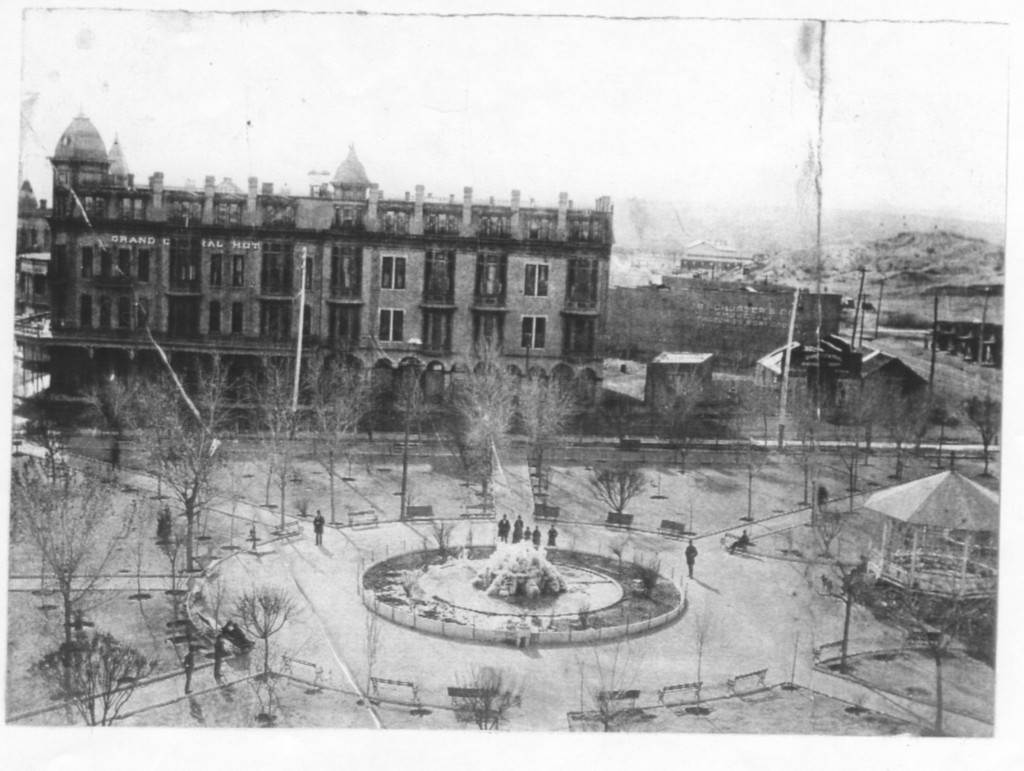 The downtown park changed with the times, but the original axial design has not been lost. It was a rather simple town square with a circle in the middle, wide sidewalks around the perimeter, angled sidewalks to the center, a water pond, and our alligators-not statutes. Real, swimming alligators!
The downtown park changed with the times, but the original axial design has not been lost. It was a rather simple town square with a circle in the middle, wide sidewalks around the perimeter, angled sidewalks to the center, a water pond, and our alligators-not statutes. Real, swimming alligators!
La Plaza de Los Lagartos grew and matured with the downtown buildings and the Placita saw the rise of the downtown buildings embracing the square, including the beautiful Trost Buildings.
U.S. soldiers who trained at Fort Bliss and Biggs Air Force Base in World War I and II, and the Korean Conflict enjoyed the alligators at the park. Millions of people from all walks of life from the El Paso region and from all over the world enjoyed the park. All roads, all streetcar lines, all buses, and all shoppers ended up at La Placita. It was where people met, enjoyed conversation, read the newspaper, or just sat at the bench to catch a bit of sun or live music from the park shell.
The alligators seldom moved. And they didn’t make any noise. That was O.K. It was the Plaza where a locomotive, a freight train, or a Pullman would run by on the north side of the square in its full glory; steam and the excitement of steel and steam noise, to make the place special.
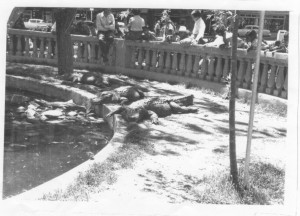 There are tons of stories of people who enjoyed the Plaza Park. Trolley and bus riders, pedestrians, downtown residents, tourists, shoppers, workers, etc. young and old, have a story to tell about the park. This is the downtown city block that has served more people per day than any other block. The Kress, the Popular, the White House, Newberry’s, Woolworth, Grants, and many other stores, generated people who used the park. The Coney Island Café, The Ellenay, the Plaza, the Wigwam, and other theater patrons used the Plaza as a destination point. Children from South El Paso came to the park because it was the only place that had grass.
There are tons of stories of people who enjoyed the Plaza Park. Trolley and bus riders, pedestrians, downtown residents, tourists, shoppers, workers, etc. young and old, have a story to tell about the park. This is the downtown city block that has served more people per day than any other block. The Kress, the Popular, the White House, Newberry’s, Woolworth, Grants, and many other stores, generated people who used the park. The Coney Island Café, The Ellenay, the Plaza, the Wigwam, and other theater patrons used the Plaza as a destination point. Children from South El Paso came to the park because it was the only place that had grass.
The alligators made an impression on people. It made it unique. It made you remember. It was El Paso.
According to the El Paso Herald, dated September 16, 1920, a prominent realtor and land developer, J. Fisher Satterthwaite was interviewed about the history of El Paso. He was the first City park commissioner of El Paso, appointed in 1882 and served for five years. Mr. Satterthwaite stated that he brought three alligators to El Paso from New Orleans in a cigar box. One of them later died. The other two lived to a ripe old age. Mr. Satterthwaite built the first pond for the original ‘gators. In time, the alligator population, through various actions, grew to as many as seven.
For over seven decades, the alligators, the circular pond with fish and turtles, and the balustrade fence were the trademark of El Paso. The alligators were the target of animal cruelty and in the mid 1960s the City moved them to the zoo.
In the 1970s, the City “improved“ the park which included the demolition of the gator cove, the pond and the balustrade circle.
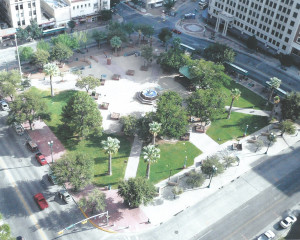 Shortly after, the City built a red brick pedestal with a water spraying system to display the alligator sculpture designed and built by renowned El Paso artist Luis Jimenez. The spray mist was devastating to the sculpture material. The City stopped the spray.
Shortly after, the City built a red brick pedestal with a water spraying system to display the alligator sculpture designed and built by renowned El Paso artist Luis Jimenez. The spray mist was devastating to the sculpture material. The City stopped the spray.
In March of 2011, the City of El Paso, in partnership with downtown businessmen and developers, began the process to hire a landscape-planning consulting firm to redesign the Plaza de Los Lagartos.
As the process progressed, it was apparent to me and to other citizens of the community that the plans being generated by the firm of SWA, while being professional in character, did not reflect the history of the park, nor were the plans reflective of the culture and social fabric of the community. Several concepts were presented. The concerns of the community were made known to City elected officials.
Specifically, the plans proposed obliterated the original 1870s diagonal axial design of the park. It removed the central circular motif the park, removed the Jimenez alligator sculpture, and infused a significant amount of desert landscaping. Other concepts presented were modern curvilinear in nature, totally unacceptable to El Paso’s downtown architectural and historical character.
On September 8, 2011, the City’s Economic Development, Planning and Tourism Legislative Review Committee voted to present the San Jacinto Plaza Park plan developed by the consultants to the Mayor and City Council within four weeks. Additionally, the Committee appointed myself to chair a citizens’ committee to review the consultant’s plan and report back to City Council within three weeks.
The San Jacinto Plaza Redesign Concept Plan Review Committee immediately began to work on the analysis of the concept plan and to develop recommendations to present to City Council.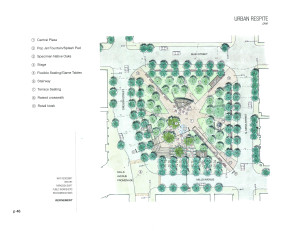
On October 18, 2011, the Review Committee went before City Council and presented their findings and recommendations, including the presentation of a concept plan developed by the citizens’ group.
The Committee plan and recommendations emphasized the recovery of green lawn areas from previous “improvement” efforts that resulted in mass areas of concrete, pavers, bricks, and a great number of concrete planter boxes.
Among other recommendations, the Review Committee’s concept plan listed the following actions:
• Reinstate the historic 1880s diagonal design pattern for the park
• Keep the Jimenez alligator sculpture in the center of the park
• Build the balustrade circular structure around the alligator sculpture
• Inner circle of evergreen trees to protect the sculpture from sun rays
• Pop jet fountains/splash pads
• Keep the Christmas tree
• Ping pong tables
• Establish a streetcar café in the park using a real and historic streetcar that actually provided service between El Paso and Ciudad Juarez, Mexico.
After the presentation, the Mayor and Council voted to incorporate the trolley café into the final plan, keep the existing alligator sculpture in the center of the park, and reinstate the axial (diagonal) design pattern into the final officially approved park plan.
The consulting firm was instructed to incorporate the major items presented to the City by the Review Committee.
The new and approved final San Jacinto redevelopment plan incorporates most elements of the Committee.
 Lacking in the final approved plan is the recovery of the green lawn areas, and incorporates a more complex design configuration, a camouflage screen to protect the alligator sculpture instead of the large evergreen trees recommended.
Lacking in the final approved plan is the recovery of the green lawn areas, and incorporates a more complex design configuration, a camouflage screen to protect the alligator sculpture instead of the large evergreen trees recommended.
Construction of the park improvements are scheduled to start sometime in July of this year.
Once the plan is implemented and completed, the citizens of El Paso will have to accept the results. In general, the Committee’s recommendations were met.
The question is: will the general public be in agreement with the results?
Nestor A. Valencia
June 24, 2013
Members of the San Jacinto Review Committee:
Nestor A. Valencia – Chair
Katherine Brennand
Miguel Juarez
Mervin Moore, AIA
Xochitl P. Valencia
Joel Guzman
Peter Svarzbein
Photographs courtesy of Nestor Valencia


